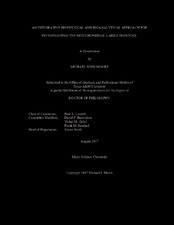| dc.description.abstract | Mitochondria contain a low-molecular-mass (LMM) pool of weakly bound iron complexes, called the labile iron pool (LIP). Although its composition and biological function remain largely uncharacterized, the LIP has been implicated in cellular iron metabolism and disease pathogenesis. In this dissertation, results obtained from Mössbauer, EPR, and UV-Vis studies were integrated with LC-ICP-MS data to investigate the chemical nature of the mitochondrial LIP.
LMM Fe, Mn, Cu, Zn, and Co complexes were detected in yeast and mammalian mitochondria. Such complexes were reproducibly observed and hypothesized to metalate mitochondrial apo-metalloproteins. The approximate mass of each complex was estimated along with its mitochondrial concentration. The predominant LMM Fe species detected in mitochondria had a mass of ~580 Da (called Fe₅₈₀) and was present in both yeast and mammalian mitochondria. Increasing the Fe concentration in the medium increased the intensity of Fe₅₈₀. Interestingly, the mitochondrial concentration of Fe₅₈₀ was ~100 µM, which was consistent with previous estimates of the mitochondrial LIP. Thus, Fe₅₈₀ was hypothesized as the cytosolic iron species that is imported into mitochondria to form the LIP. Treatment with metal chelators demonstrated that Fe₅₈₀ was labile.
A yeast strain lacking mitochondrial Fe importers, Mrs3/4, was characterized using biophysical and bioanalytical methods (ΔΔ). Respiring Fe-deficient ΔΔ cells exhibited a “slow-growth” phenotype that was ameliorated under Fe-sufficient conditions. ΔΔ cells accumulated more Fe than wild-type (WT) cells, even under Fe-sufficient conditions, indicating Fe dysregulation. ΔΔ cells accumulated NHHS Feᴵᴵ and Feᴵᴵᴵ in the cytosol and vacuoles, respectively. Fe-deficient ΔΔ mitochondria accumulated Feᴵᴵᴵ oxyhydroxide nanoparticles and were devoid of central doublet ([Fe₄S₄] 2+ and LS Feᴵᴵ hemes), whereas Fe-sufficient ΔΔ mitochondria contained comparable levels of central doublet but less NHHS Feᴵᴵ relative to WT. This suggested the mitochondrial NHHS Feᴵᴵ pool was reduced in Fe-sufficient ΔΔ cells. Fe₅₈₀ was absent in Fe-deficient ΔΔ mitochondria but present under Fe-sufficient conditions. Two candidate masses {664.46 and 665.46 amu} and {685.39 and 686.39 amu} were determined for Fe₅₈₀. Viewed comprehensively, this study provides strong evidence that the mitochondrial NHHS Feᴵᴵ pool is composed predominantly of Fe₅₈₀ and that the size of this pool controls cellular Fe homeostasis. | en |


